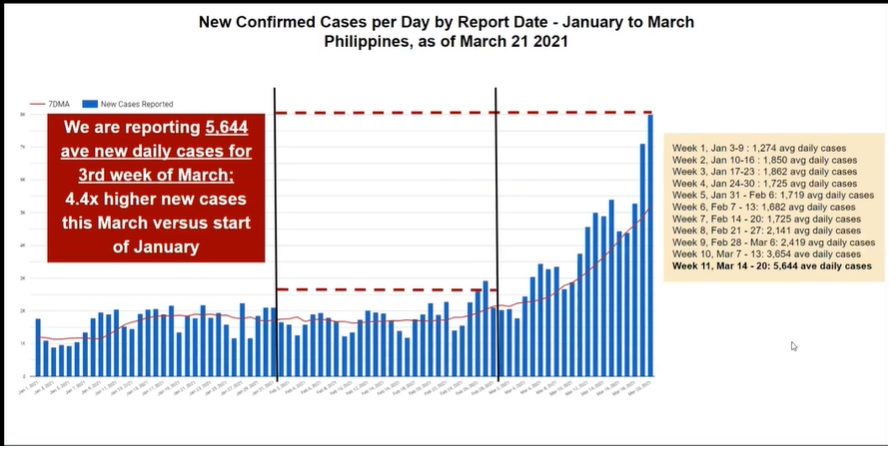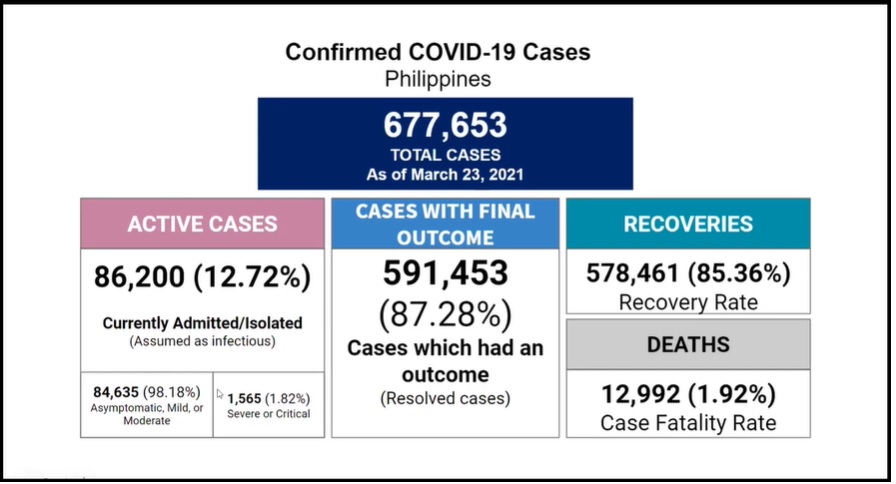MANILA – The surge in number of coronavirus cases has surpassed the peak recorded in August last year, an official of the Department of Health (DOH) said Wednesday.
At an online media briefing, DOH Epidemiology Bureau Director Dr. Alethea de Guzman said the cases are still increasing at a fast rate, with National Capital Region (NCR) at "high risk" and five other regions -- Central Luzon, Cagayan Valley, Region 4-A (Calabarzon), Western Visayas and Caraga -- at "moderate risk" based on the speed of the increase and number of population affected.
"Ang mga NCR cities natin ay naka-high and critical risk na po, ibig sabihin ang pagtaas ng kaso ay more than 200 percent na sa ilang siyudad (Cities within NCR are now at high and critical risk which means the rise in number of cases is more than 200 percent in some cities)," she added.
According to DOH data as of March 21, an average of 5,644 new cases is reported daily for the third week of March. This number is 4.4 times higher than the number of cases reported by the start of January.

Even with a "high risk" classification, de Guzman said the NCR's health care utilization rate remains at a "safe zone".
"Mahalaga po 'yun sapagkat ito ay nagsisilbing buffer. Gayunpaman kailangan natin ma-monitor ang intensive care unit rate dahil doon nalalagak ang severe at critical cases (This is important because it serves as buffer. However, we have to monitor the intensive care unit rate because that's where the severe and critical cases are)," she said.
Latest data as of March 20 show that the cities of Marikina, Mandaluyong, Caloocan, San Juan, Pasig, Muntinlupa, Quezon, Paranaque and the municipality of Pateros are at critical risk.
New variants in samples of international travelers
De Guzman said about 85 samples subjected to genome sequencing tested positive for the B.1.1.7 or B.1.351 and are from international travelers. About 8.7 percent of 4,310 samples are positive for one variant of concern.
“At least one local case with a variant of concern was identified in all the 17 NCR cities and municipalities,” de Guzman said.
Seven regions are positive for B.1.1.7 variant, including Region 1 with one case; Region 3, four; CAR, 41; NCR 76; Region 4-A, five; Region 6,1; and Region 10, one.
Six regions are positive for B.1.351 variant – Region 2, one; Region 3, one; NCR, 105; Region 4-A, three; and Region 10, one.

“Pero kailangan natin bantayan ang ating ROFs [returning overseas Filipinos] it comprises 23 percent of all our sequenced samples and this emphasizes na kelangan strikto ang ating (But we need to monitor our ROFs [because] it comprises 23 percent of all our sequenced samples and this emphasizes the need for stricter) border control,” de Guzman said.
Responding to the apprehensions of the public, de Guzman noted that the variants of concern do not have an effect on the clinical management of the cases.
“Hindi po siya nakakapagpapalala ng sakit, hindi rin nakakapagpadami ng deaths natin, ang clinical management po nito ay pareho (These don’t make the disease severe, these don’t cause increased deaths, the clinical management of these are the same)," she said.
While there is an increase in active cases, the percentage of patients in severe or critical condition remains under two percent.
“Dahil po ito sa pagkakaroon ng magandang referral system at pag-ensure na mayroon tayong sapat na beds for severe and critical [patients with Covid-19] (This is because we have a good referral system to ensure that we have enough beds for severe and critical patients),” de Guzman said.
She, however, said the surge of cases could end with the cooperation of individuals, establishments, and local government units.
“Not only by observing and implementing the minimum public health standards, also the city protocols to lower the risk of being infected or infecting others,” she added. (PNA)
